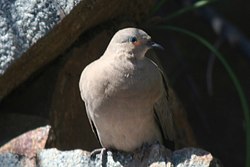| Metriopelia | |
|---|---|
 | |
| Black-winged ground dove | |
| Scientific classification | |
| Domain: | Eukaryota |
| Kingdom: | Animalia |
| Phylum: | Chordata |
| Class: | Aves |
| Order: | Columbiformes |
| Family: | Columbidae |
| Subfamily: | Columbinae |
| Genus: | Metriopelia Bonaparte, 1855 |
| Type species | |
| Columba melanoptera [1] Gmelin, 1789 | |
| Species | |
See text | |
Metriopelia is a genus of ground doves containing four species that live in the dry, upland habitats along the Andean mountain chain in South America. They have large wings and three species have orange skin around the eyes.
The genus was introduced by the French naturalist Charles Lucien Bonaparte in 1855 with the black-winged ground dove (Metriopelia melanoptera) as the type species. [2] The name of the genus combines the Ancient Greek metrios meaning "modest" with peleia meaning "dove". [3]
The four species in the genus are: [4]
| Common name | Scientific name and subspecies | Range | Size and ecology | IUCN status and estimated population |
|---|---|---|---|---|
| Bare-faced ground dove | Metriopelia ceciliae (Lesson, 1845) | Argentina, Bolivia, Chile, and Peru | Size: Habitat: Diet: | LC |
| Black-winged ground dove | Metriopelia melanoptera (Molina, 1782) Two subspecies
| Argentina, Bolivia, Chile, Colombia, Ecuador, and Peru. | Size: Habitat: Diet: | LC |
| Golden-spotted ground dove | Metriopelia aymara (Prévost, 1840) | Argentina, Bolivia, Chile, and Peru | Size: Habitat: Diet: | LC |
| Moreno's ground dove | Metriopelia morenoi (Sharpe, 1902) | Argentina | Size: Habitat: Diet: | LC |




